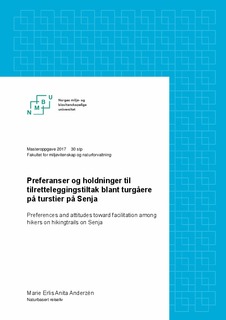| dc.contributor.advisor | Stensland, Stian | |
| dc.contributor.author | Anderzén, Marie Erlis Anita | |
| dc.coverage.spatial | Norge, Senja | nb_NO |
| dc.date.accessioned | 2017-08-31T13:02:45Z | |
| dc.date.available | 2017-08-31T13:02:45Z | |
| dc.date.issued | 2017 | |
| dc.identifier.uri | http://hdl.handle.net/11250/2452616 | |
| dc.description.abstract | Reiselivsnæringen har hatt en stor vekst de seneste årene. Dette er noe naturbaserte reiselivsdestinasjoner har fått merke mer og mer av. Med et økende antall turister som ankommer Nord-Norge og Senja hvert år, så Troms Fylkeskommune og Midt-Troms Friluftsråd seg nødt til å kartlegge de besøkende for å få et overblikk over hvem som besøker øya, slik at de får et grunnlag de kan basere forvaltningsmessige beslutninger på. Det ble derfor satt i gang et større prosjekt rundt besøkskartlegging langs turstier og i verneområder på Senja.
Det startet med en datainnsamling sommeren 2016, ved hjelp av svarkasser og ferdselstellere. Svarkassene ble satt ut 28.6 og tatt ned 30.9, og ga 1405 svar. Svarkasseundersøkelsen ble for min del primært brukt til å samle inn kontaktinformasjon, men noe data ble også benyttet i oppgaven. De innsamlede e-postadressene (582) fra svarkasseundersøkelsen ble benyttet til å samle inn det datagrunnlaget som denne masteroppgaven er basert på. Etterundersøkelsen resulterte i 254 svar. Oppgaven har en kvantitativ tilnærming, og jeg ønsket å finne ut hvilke karaktertrekk, preferanser og holdninger brukerne av turstiene på Senja har til ulike tilretteleggingstiltak, og hva forvaltningen kan gjøre for å møte utfordringer knyttet til økt bruk.
Det ble gjort krysstabuleringer og enveis variansanalyse (ANOVA) for å avdekke sammenhenger mellom sosiodemografiske faktorer, slik som kjønn, alder og geografiske inndelinger. Det ble også gjort en faktoranalyse basert på tilretteleggingstiltak. Denne ga tre faktorgrupper; «Tilrettelegging rundt stiene», «Stiene» og «Infrastruktur». Det ble deretter sett på forskjeller og ulikheter mellom purismegruppene når det gjelder tilretteleggingstiltak, samt forskjeller og ulikheter gjennom samme type analyse mellom de ulike turstiene.
De mest interessante funnene fra studien var at det ikke var betydelige forskjeller mellom de tre purismegruppene som besøkte Senja sommeren 2016. De hadde relativt like motiver og holdninger til tilretteleggingstiltak. Dette forenkler forvaltningens arbeid med tilrettelegging i stor grad, da de ikke trenger å ta stor høyde for forskjeller mellom behov for tilrettelegging blant dagens besøkende. | nb_NO |
| dc.description.abstract | The tourism business has had an increase through the past decades. This is something that the nature-based tourism businesses in Norway notices to an increasing degree. With an increasing number of tourists visiting the north of Norway and Senja each year, Troms Fylkeskommune and Midt-Troms Friluftsråd concluded that they needed to map out the visitors, to get an overview over who they are, to be able to make decisions based on knowledge in the future.
This is the reason why a large project of visitor monitoring was started during the summer of 2016 (28.6-30.9). On several hiking trails, and in one national park, there was placed out self-registration boxes with a response-form to collect information about the visitors. In addition, visitor counters were placed next to each trail. This survey resulted in a total of 1405 collected answers and 582 e-mails, that we used to collect further information, upon which this thesis is based. In total we received 254 answers to the online survey. The thesis has a quantitative approach, and I wanted to find out what characteristics, preferences and attitude the visitors on certain hiking trails on Senja have towards certain types of facilitation, and what the management can do to face the challenges connected to an increase in use.
Several analyses were made with the collected data, to find similarities and differences. A crosstabulation and a one-way ANOVA were done to uncover contexts within sociodemographic factors. A factor analysis based upon the different kinds of facilitation produced three factor-groups; Facilitation around the trails, Trails and Infrastructure. The study focused on the wilderness purism scale, facilitation and similarities and differences between the visitors to different hiking trails.
The most interesting findings of this study was that there were no significant differences between the three purism groups that visited Senja during the summer of 2016. They had similar motives to travel to Senja, and similar attitudes towards facilitation on the island. This simplifies the managerial work regarding facilitation to some extent, as they do not need to regard differences in needs regarding facilitation. | nb_NO |
| dc.language.iso | nob | nb_NO |
| dc.publisher | Norwegian University of Life Sciences, Ås | nb_NO |
| dc.rights | Attribution-NonCommercial-NoDerivatives 4.0 Internasjonal | * |
| dc.rights.uri | http://creativecommons.org/licenses/by-nc-nd/4.0/deed.no | * |
| dc.subject | naturbasert reiseliv | nb_NO |
| dc.subject | friluftsliv | nb_NO |
| dc.subject | turstier | nb_NO |
| dc.subject | tilrettelegging | nb_NO |
| dc.subject | purismeskalaen | nb_NO |
| dc.title | Preferanser og holdninger til tilretteleggingstiltak blant turgåere på turstier på Senja | nb_NO |
| dc.title.alternative | Preferences and attitudes toward facilitation among hikers on hikingtrails on Senja | nb_NO |
| dc.type | Master thesis | nb_NO |
| dc.subject.nsi | VDP::Samfunnsvitenskap: 200 | nb_NO |
| dc.description.localcode | M-REIS | nb_NO |

